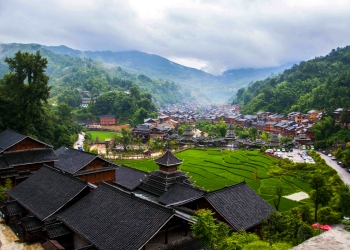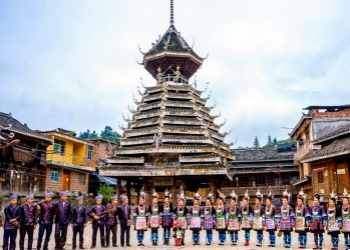Nestled in the heart of Guizhou, a land rich in history and mystique, lie ethnic minority villages that are not only scenic but also repositories of vibrant cultural treasures. These villages, like glittering pearls embedded among the verdant hills and glistening rivers, exude an unmistakable charm.
Guizhou is one of the provinces with the largest number of ethnic minorities in China, with 17 ethnic minorities living here and countless villages. Guizhou Province has 28 national-level and provincial-level famous villages, 757 traditional Chinese villages, and 1,640 Chinese and provincial-level ethnic minority villages. Generally speaking, tourists to Guizhou ethnic groups visit ethnic minority villages in southeast Guizhou, such as Xijiang Miao Village, Zhaoxing Dong Village, Basha Miao Village, etc.
Qianhu Miao Village displays an epic of Miao development and becomes an attraction for viewing and studying Miao traditional culture. It has more than 1,400 households and over 6,000 people, and the Miao population accounts for 99.5%, which is the largest Miao-inhabited village in China. Xijiang Qianhu Miao Village boasts a rich Miao culture, with Miao architecture, clothing, silver jewelry, language, cuisine, and traditional customs being well-preserved and visible throughout the village.
Don't miss out on the Welcome-Guest Ceremony and the captivating Singing and Dancing Performance. Moreover, it's highly advisable to ascend the viewing platform to witness a breathtaking panorama of the entire village and capture some stunning photographs. And if you decide to stay overnight in the village, make sure to visit the viewing platform again for the spectacular night view. As the sun sets, the whole Xijiang Miao Village will come to life with twinkling lights.
Location: Xijiang Town, Leishan County, Qiandongnan Miao and Dong Autonomous Prefecture; about 30 km from Kaili City
Recommended visiting time: 1day
Best activities to do: Photography
Ticket: CNY110
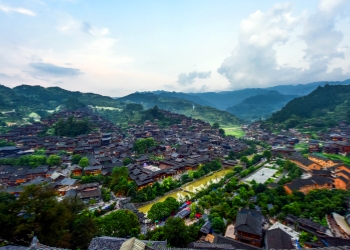

Langde Miao Village
Langde Miao Village, situated within the Langde Town of Leishan County, lies approximately 15 kilometers from the county seat of Leishan and 28 kilometers from Kaili City. This hamlet, consisting of merely a hundred households, was once the venue for the Olympic torch relay in 2008. Prior to the rise of Xijiang's fame, Langde was the first to be developed as a tourist attraction showcasing Miao ethnic customs. As Xijiang gradually gained popularity, Langde reverted to its former tranquility and has since maintained a pristine and authentic way of life. The village is divided into Upper Langde and Lower Langde, with Upper Langde currently open to the public.
The entire Upper Langde Village is constructed along the contours of the hillside, with wooden buildings topped by black tiles arranged in orderly rows, exhibiting a harmonious layout. The cobblestone paths are quaint and serene, flanked by lush trees growing densely on the hillsides. A murmuring river flows gracefully in front of the village, with a covered bridge spanning its width. As you step towards the entrance of the village, you can witness the sight of beautifully dressed young women singing captivating toast songs, holding horn cups filled with liquor, and dancing joyfully to the melodious sounds of the lusheng played by the young men. This lively spectacle warmly welcomes the guests who have traveled far to visit.
Location: Langde Shangzhai, Leishan County, Qiandongnan Miao and Dong Autonomous Prefectur; about 28 km from Kaili City
Recommended visiting time: about 2-3 hours
Best activities to do: Experience local customs, photography
Ticket price: CNY60 (sightseeing bus included)


Basha Miao Village
Basha Miao Village, situated approximately 8.5 kilometers from Congjiang County, stands out as a unique gem amidst China's vast cultural landscape. It is a must-visit attraction for anyone traveling to Qiandongnan, offering a glimpse into a rich and ancient heritage.
Legend has it that the Basha people trace their lineage back to Chi You, a mythical warrior from ancient China, and their traditions span over 2,000 years. The men of Basha dress like ancient warriors, adorned with black waistcoats, straight-legged trousers, and swords, often accompanied by hunting dogs and firearms. The women, on the other hand, wear black shirts paired with pleated skirts, simple yet adorned with intricate embroidery in vibrant colors.
Despite the strict regulations on firearms in China, the men of Basha are uniquely allowed to carry and use guns as a means of preserving their cherished traditions. This distinctive custom has earned Basha the moniker of "the last gunslinger village in China,"
Outside the village, Basha men stand in a line, firing their guns skyward in a traditional ceremony to welcome visitors. In the village square, vibrant Miao dances are performed, with the men and women dancing gracefully to the rhythmic beats of traditional drums and flutes. (performances are held at 09:00, 11:00 and 15:00 everyday)
Location: Basha Village, Bingmei Town, Congjiang County, Qiandongnan Miao and Dong Autonomous Prefecture; about 245 km from Kaili City
Recommended visiting time: about 2-3 hours
Best activities to do: Photography, watch performance
Ticket price: CNY80 (sightseeing bus excluded)
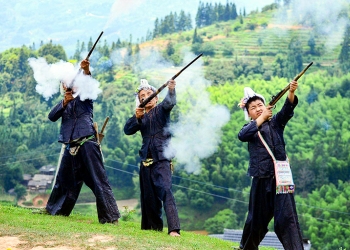
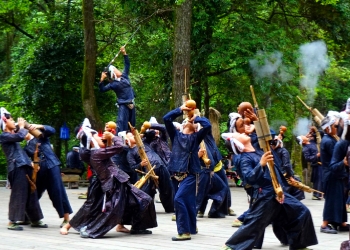
Matang Gejia Village
Matang Gejia Village, located in the northwest of Kaili City. This secluded hamlet is populated by approximately 400 members of the unique Gejia ethnic group, a subset of the broader Miao community that maintains a distinct identity within Guizhou. According to legend, the Gejia people descend from the heroic Hou Yi, renowned for his mythical feat of shooting down nine scorching suns to save his people. This rich folklore is a cornerstone of the Gejia culture, shaping their traditions and way of life.
Location: Longcheng Town, Kaili City, Qiandongnan Miao and Dong Autonomous Prefecture; about 21 km from Kaili City, which needs about 0.5-1 hour’s driving;
Recommended visiting time: about 1-3 hours;
Best activities to do: Photography, experience Gejia batik
Ticket: Free
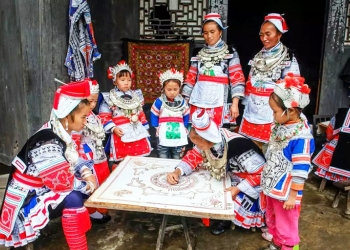
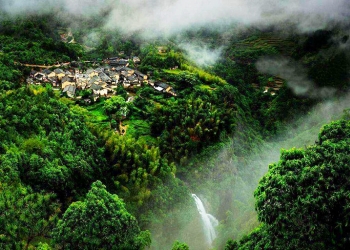
Xinqiao Miao Village
Xinqiao Miao Village is renowned for its "skirt Miao" culture, a unique subset of the Miao people who are known for their distinctive short skirts. These skirts, often adorned with intricate embroidery and vibrant colors, are a symbol of the Miao women's craftsmanship and beauty.
What's more, Xinqiao Miao Village is also famous for its "aquatic barns." These unique structures, constructed entirely from wood and situated in water bodies, are a rare sight and a testament to the ingenuity of the Miao people. These barns, which have been in use for over 600 years, are not only a practical solution for storing grain but also a symbol of the village's rich agricultural heritage.
Location: Xinqiao Village, Leishan County, Qiandongnan Miao and Dong Autonomous Prefecture; about 53 km from Kaili City
Recommended visiting time: about 2 hours
Best activities to do: Photography
Ticket: Free
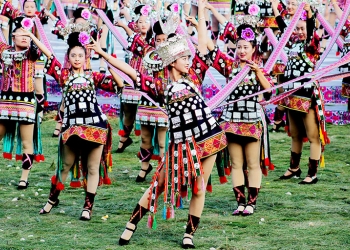
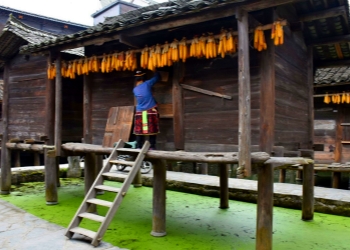
This ancient hamlet, situated in the heart of Liping County, is not only one of the largest Dong villages in China but also a national 5A-level tourist attraction, drawing visitors from all corners of the world.
The drum tower complex in Zhaoxing Dong Village is a remarkable architectural ensemble that showcases the unique cultural heritage of the Dong people. Composed of five distinct drum towers, each named after a cardinal virtue - Ren (benevolence), Yi (righteousness), Li (courtesy), Zhi (wisdom), and Xin (faithfulness) . The village is also renowned for its wind and rain bridges, which span the rivers and streams, connecting different parts of the community. These bridges, with their covered walkways and benches, provide a place for people to gather, chat, and enjoy the scenery.
In addition to its architectural wonders, Zhaoxing Dong Village is also known for its vibrant cultural activities. Among the rich tapestry of celebrations, the Grain Rain Festival and the Muddy Men Festival are two particularly fascinating events that draw visitors from far and wide. During this celebration, the Dong people gather to perform traditional songs and dances, participate in singer competitions, and share their rich cultural heritage with visitors.
Location: Zhaoxing Town, Liping County, Qiandongnan Miao and Dong Autonomous Prefecture; about 214 km from Kaili City
Recommended visiting time: about 2-3 hours;
Best Activities to do: Hiking
Ticket price: CNY 80

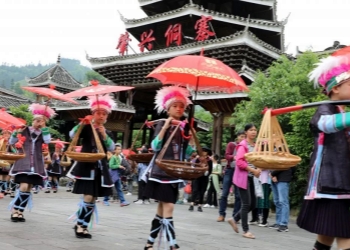
Huanggang Dong Village
Boasting a population of 1,600 across 320 households, Huanggang Dong Village is not just a community; it's a vibrant tapestry of Dong traditions and customs. Among its many noteworthy features, the village is renowned for its five drum towers, Wind and Rain Bridges, and its status as one of the birthplaces of the Grand Song of Dong People.
The entrance to the village is marked by two Wind and Rain Bridges, adorned with intricate patterns of dragons and phoenixes, symbolizing good fortune and prosperity. The five drum towers, each with its unique design and beautiful decorations, are another highlight of Huanggang Dong Village.
Huanggang Dong Village stands out as a cultural beacon, unique in its celebration of the "Goddess of Thunder Worship Festival" known locally as Han Tian Jie (喊天节). This festival, observed on the fifteenth day of the sixth lunar month, is a vibrant and colorful display of Dong traditions and beliefs. On the day of Han Tian Jie, the village comes alive with a series of rituals. Locals gather in the village square, dressed in their finest traditional attire, to offer prayers and perform dances in honor of the deity. The air is filled with the sound of drums, gongs, and singing, creating a festive and spirited atmosphere.
In addition to Han Tian Jie, Huanggang Dong Village also hosts another significant festival known as "Tai Guan Ren" on the third day of the first lunar month. This festival marks the beginning of a new year and is celebrated with a lively parade that winds through the streets of the village. Locals deck out their houses with festive decorations, prepare traditional cuisine, and gather to watch the parade, which features dragon and lion dances, and other performances that reflect the richness and diversity of Dong culture.
Location: Shuangjiang Town, Liping County, Qiandongnan Miao and Dong Autonomous Prefecture; about 204 km from Kaili City
Recommended visiting time: about 2-3 hours;
Best activities to do: Photography
Ticket: Free
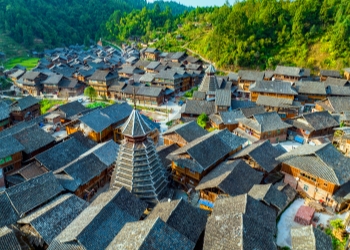
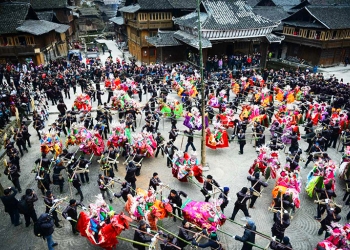
Xiaohuang Dong Village
Nestled deep within the enchanting landscapes of Qiandongnan, Xiaohuang Dong Village stands as a secluded gem, a mere 22 kilometers from the bustling Congjiang County.
Xiaohuang Dong Village has earned the moniker of the "Village of Grand Songs," a testament to the exceptional talent of its Dong inhabitants in performing the rich polyphonic folk melodies known as "Dage" (Grand Songs). This village has been honored with the prestigious title of "the Village of Chinese Folk Art" for its diligent preservation of the Dong singing tradition.
On auspicious festivals and grand occasions, the villagers, attired in their vibrant traditional costumes, gather around the drum tower to perform the Grand Songs. One such notable event is the annual Congjiang Grand Song Festival, which takes place on November 28. This festival is a celebration of Dong culture and music, drawing travelers from near and far to witness the grandeur of the performances.
Location: Gaozeng Town, Congjiang County, Qiandongnan Miao and Dong Autonomous Prefecture; about 210 km from Kaili City
Recommended visiting time: about 2-3 hours;
Best activities to do: Photography, watch performance
Ticket: Free
